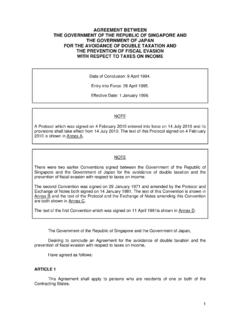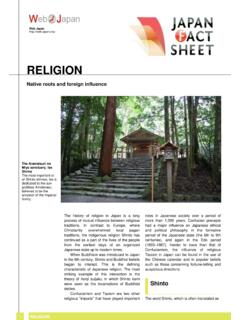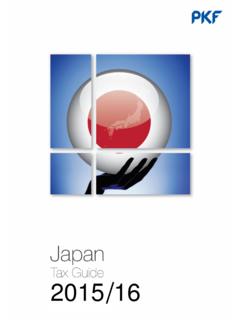Transcription of Variations of Emotional Display Rules Within and …
1 Variations of Emotional Display Rules Within and Across Cultures:A Comparison between Canada, USA, and JapanSaba SafdarUniversity of GuelphWolfgang FriedlmeierGrand Valley State UniversityDavid MatsumotoSan Francisco State UniversitySeung Hee YooYale UniversityCatherine T. KwantesUniversity of WindsorHisako KakaiAoyama Gakuin UniversityEri ShigemasuYamanashi Gakuin UniversityThis study investigates Emotional Display Rules for seven basic emotions. The main goal was to compareemotional Display Rules of Canadians, US Americans, and Japanese across as well as Within cultures regardingthe specific emotion, the type of interaction partner, and gender.
2 A total of 835 university students participatedin the study. The results indicate that Japanese Display Rules permit the expression of powerful (anger,contempt, and disgust) significantly less than those of the two North American samples. Japanese also thinkthat they should express positive emotions (happiness, surprise) significantly less than the Canadian , Japanese varied the Display Rules for different interaction partners more than the two NorthAmerican samples did only for powerful emotions. Gender differences were similar across all three culturalgroups. Men expressed powerful emotions more than women and women expressed powerless emotions(sadness, fear) and happiness more than men.
3 Depending on the type of emotion and interaction partner someshared Display Rules occurred across culture and gender. The implications of these findings are discussed inrelation to cultural dimensions and other cultural : Emotional Display Rules , norms of emotions, cross-cultural comparison, ingroup/outgroupThe notion of cultural Display Rules was first introduced byEkman and Friesen (1969) as a hypothetical construct to explainthe observed differences in a study comparing Japanese and Amer-ican students, since when it has been a central concept in the studyof culture and emotion.
4 Cultural Display Rules are seen as importantparts of any culture; they can be defined as culturally prescribedrules, which are learnt early in life through socialization. Theserules influence the Emotional expression of people from any cul-ture depending on what that particular culture has characterised asan acceptable or unacceptable expression of emotion (Matsumoto,Kasri, & Kooken, 1999). These culturally shared norms dictatehow, when, and to whom people should express their the popularity of this concept, few studies have tried toinvestigate Display Rules in a direct way.
5 The cross-cultural projectorganised by Matsumoto, Yoo, Fontaine, Anguas-Wong, Arriola,Ataca, et al. (2008) tries to fill this gap. Using the Display RuleAssessment Inventory (DRAI), Display Rules are assessed as cog-nitive representations that guide individuals expressive part of this multinational study, the present article focuses on aspecific comparison between three cultural groups, namely japan ,Canada, and the United States, regarding Emotional Display all three nations are wealthy, industrialised, and moderndemocratic countries, they are similar in economic and politicalterms but differ in cultural factors (such as norms, values, andbehavioural Rules )
6 That are important in describing and explainingdifferences in individual functioning across cultures ( , Heine,Saba Safdar, Department of Psychology, University of Guelph; WolfgangFriedlmeier, Department of Psychology, Grand Valley State University; DavidMatsumoto, San Francisco State University; Seung Hee Yoo, Yale University;Catherine T. Kwantes, Department of Psychology, University of Windsor;Hisako Kakai, Graduate School of International Politics, Economics andCommunication, Aoyama Gakuin University; Eri Shigemasu, Department ofPolitics and Public Administration, Yamanashi Gakuin first author would like to thank Dr.)
7 J. Rees Lewis for his valuablefeedback and editorial comments on earlier versions of this article. Thesecond author would like to thank Prof. Hideo Kojima, Prof. MasahikoTsuchiya, and Dr. Shoei Tsai for their strong support in carrying out thestudy in Nagoya, Kyoto, and Nara; as well as to acknowledge the financialsupport from the Faculty Research and Development Center at GVSU. Theauthors would also like to thank the reviewers for their constructivecomments on earlier versions of the concerning this article should be addressed to should bedirected to Saba Safdar, Psychology Department, University of Guelph,Guelph, Ontario, N1G 2W1.
8 E-mail: Journal of Behavioural Science 2009 Canadian Psychological Association2009, Vol. 41, No. 1, 1 100008-400X/09/$ DOI: ; Matsumoto & Juang, 2008). Therefore, we assume thatdifferences in Emotional Display Rules across these three culturescan be mainly explained by referring to distinct norms, values, andbeliefs. Despite globalization and modernization, Japanese culturecontinues to be shaped by Confucian and Buddhist thought, withits strong emphasis on harmony and individual commitment to thesocial group. Canada and the United States, in contrast, are cul-tures embedded in the tradition of Christian thought that placesgreat value on individual fulfillment (Hofstede, 2001).
9 We recog-nise that cultures are subject to constant reconstruction, that thesecultures are not homogeneous, and that some societies ( , Can-ada and the ) are more heterogeneous than others ( , japan ).Nevertheless, it is valid to speak of generalised norms in differentcultures (Markus & Kitayama, 1991). In Hofstede s (2001) anal-ysis, the United States ranked 1 on the individualism dimension,and Canada ranked 4, out of the 53 countries studied, making themtwo of the most individualistic countries. In contrast, japan ranked22, an indication of a relatively collectivistic society.
10 On theMasculinity Index (MAS), which focuses on the degree the societyreinforces gender differentiation, japan ranked 1, the United Statesranked 15, and Canada ranked 24, indicating that the Japaneseendorse the highest masculinity norms of the 53 countries the United States and Canada scored above the medianon this dimension, the ranking of the United States is considerablylower than japan , and Canada is the lowest ranking of the do not use these constructs as simple dimensions but ratherconceive of them as representing distillations of many sociopsy-chological phenomena (including societal norms.)












